Illinois Crop Update – June 21, 2024
Emily Hansen – Commercial Agriculture Educator
LaSalle County
Soil Conditions: Near Normal
Like much of the state, in LaSalle County it has been hot with only one day in the past week having some scattered showers. There are some scattered thunderstorms in the forecast for next week, though. Overall, crops are still looking good, but the soil is starting to dry out a bit on top. Corn at the IVCC research and demonstration plots is at V5, and soy is at V2/3 (both planted May 20). Later planted or replanted crops in LaSalle County are at similar maturity, but earlier planted corn is reaching V10 – V11 stage and some earlier soy is getting close to R1.
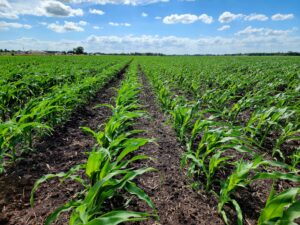
Figure 1: Corn at IVCC plots
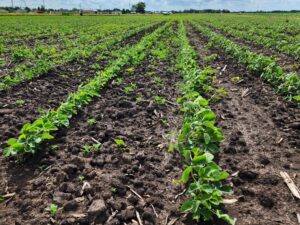
Figure 2: Soy at IVCC plots
Russ Higgins – Commercial Agriculture Educator
Grundy County
Soil Conditions: Mildly Dry (soil is drier than normal, plant growth may have slowed)
A shift in the 2024 growing season, we have transitioned from fields being wet, saturated and underwater to having some version of hot, dry and stressed crops in many areas of northeast Illinois. Many soy fields have received their post herbicide and are slowly putting out new trifoliates because of unfavorable growing conditions. Uneven corn fields can be found in areas most effected by heavy rainfall events earlier in the season. Earliest planted corn has reached V11 to V12 growth stage. While scouting (a job best done early morning with current temperatures) I noted fungal growth developing near whorls and on corn leaves. My prognosis is an early season infection of corn smut, to be confirmed by the University of Illinois Plant Clinic. In the fields visited, the infection appears to have a varietal influence.
For those in northern Illinois, I always encourage farmers to be aware of what is happening downstate to alert us to potential issues we may encounter later. Looking at information from neighboring states is beneficial as well, and recently both Iowa and Indiana confirmed the presence of tar spot. In both states it is considered one of the earlier dates for confirmation of the disease. The annual spread of the disease can be followed on the Corn ipmPIPE – https://corn.ipmpipe.org/tarspot/.
For disease and insect identification/verification, samples can be submitted to the University of Illinois Plant Clinic. Sample preparation and submission procedures can be found on their website – https://extension.illinois.edu/plant-clinic. The Plant Clinic is currently offering free sample screening for corn tar spot and SCN egg counts through the end of August (funded by the Illinois Soybean Association). Please submit samples with the appropriate forms to help ensure efficient sample processing and results delivery.
Be on the lookout and be safe when working in the hot weather!

Figure 3: Soy after post herbicide application
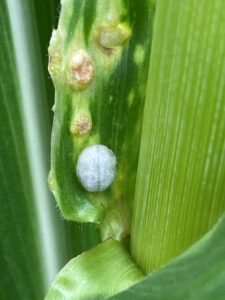
Figure 4: Fungal growth in whorls

Figure 5: Growth on leaf tissue
Reagan Tibbs – Commercial Agriculture Educator
Logan County
Soil Conditions: Mildly Dry (soil is drier than normal, plant growth may have slowed)
High temperatures have entered the area and are putting pressure on crops in Logan, Menard, and Sangamon counties. While there has not been a major rainfall event for some time, and the topsoil moisture supply is lower, there is still moisture down further in the root zone that is allowing crops to receive water. The forecast shows no break in the heat anytime soon, and chances for rain each day remain in flux. Most of the crops still appear to be healthy and have yet to exhibit signs of heat stress. There are some crops, especially ones in sandier soils, that are beginning to exhibit signs of stress. Not much else has changed in the way of growing conditions across the three counties.
Talon Becker – Commercial Agriculture Specialist
Douglas County
Soil Conditions: Mildly Dry (soil is drier than normal, plant growth may have slowed)
The recent hot weather and relative lack of rain is starting to show in the corn and soybean fields in Douglas County. Estimates from the Midwestern Regional Climate Center show the county has received approximately 1 – 1.5 inches of rain since the first of the month, which is 1.5 – 2 inches below the 30-year average (1991 – 2020). Most corn fields I saw during my drive around the county in the early afternoon were showing some degree of drought stress with rolled leaves. More mature plants at V10+ were generally only showing rolled leaves near the top of the plant, while leaves on corn still in the V3-V6 were fully rolled up. I saw an even greater range in soybean growth stage across the county, with some fields recently emerged and still at VC while others were well into flowering with most plants at R2. Weed control was also variable. Although most fields looked relatively clean, I found a couple corn fields with heavy waterhemp pressure and even more soybean fields with well-established waterhemp, marestail, volunteer corn, and some morningglories starting to take off.

Figure 6: Estimated accumulated precipitation and departure from mean (1991 – 2020); June 1 – 19 — Midwestern Regional Climate Center
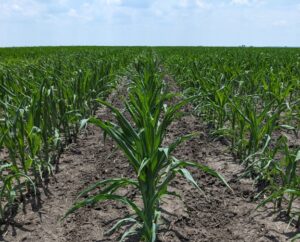
Figure 7: Recently sidedressed ~V6 corn showing signs of drought stress
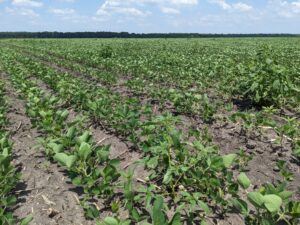
Figure 8: Soybean field with waterhemp of various sizes in the foreground and volunteer corn patches in the background





